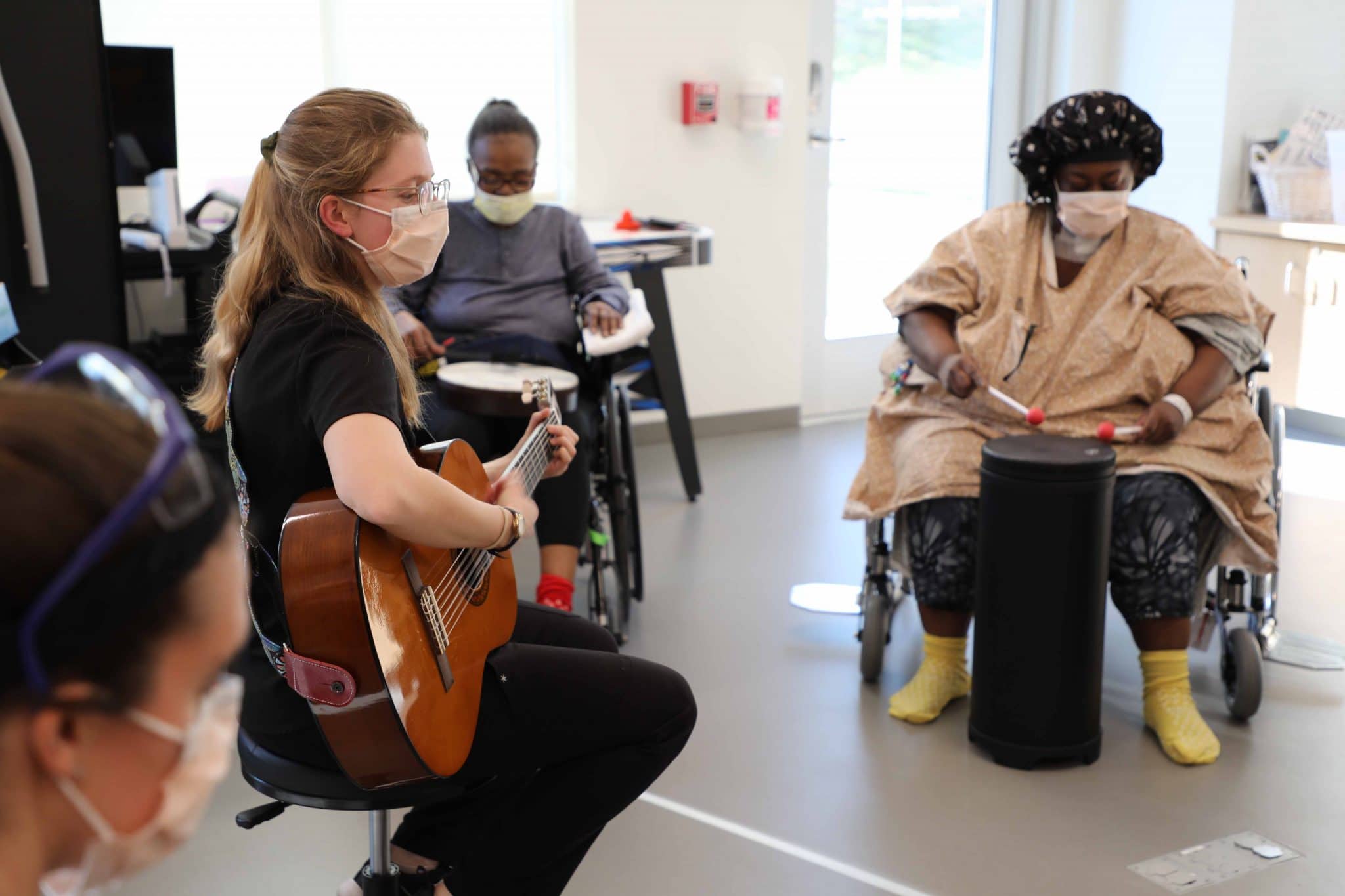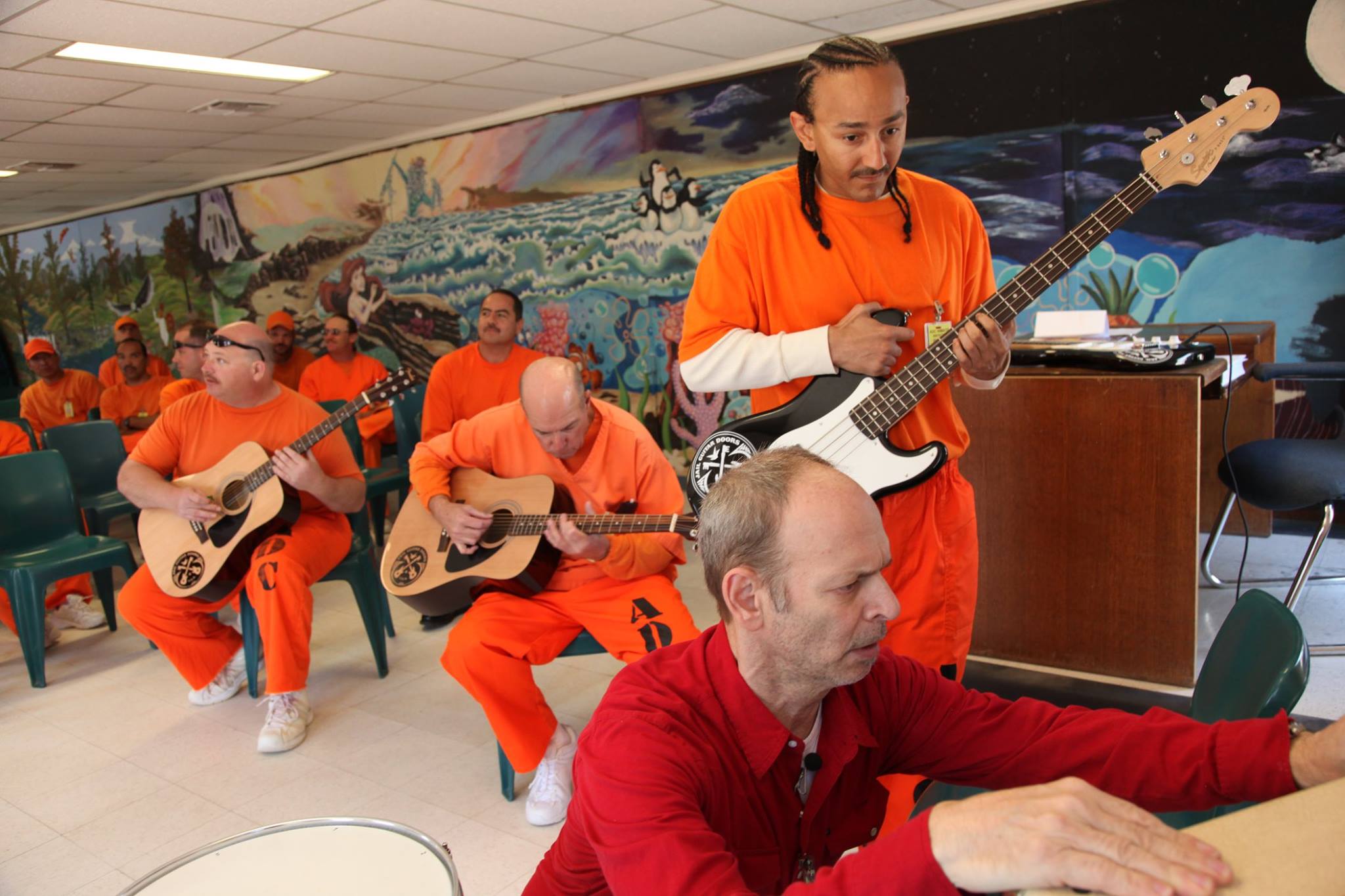Home>Events & Info>Music Therapy>How To Learn Music Therapy Session


Music Therapy
How To Learn Music Therapy Session
Modified: February 19, 2024
Discover the benefits of music therapy and learn how to conduct effective music therapy sessions. Enhance your understanding of the power of music in promoting emotional and physical well-being.
(Many of the links in this article redirect to a specific reviewed product. Your purchase of these products through affiliate links helps to generate commission for AudioLover.com, at no extra cost. Learn more)
Table of Contents
Introduction
Welcome to the world of music therapy! Music therapy is a unique and powerful form of therapy that utilizes the healing power of music to address various physical, emotional, cognitive, and social needs of individuals. With origins dating back to ancient civilizations, music therapy has evolved into a well-established field recognized by healthcare professionals worldwide.
Music therapy is an evidence-based practice conducted by trained professionals known as music therapists. These therapists carefully select and create music interventions tailored to meet the specific needs of their clients. The therapeutic use of music can be instrumental (using instruments) or vocal (using the voice), and it can encompass various techniques such as improvisation, songwriting, and active listening.
Through active participation in music therapy sessions, individuals can experience a wide range of benefits. Music has the ability to stimulate the brain, evoke emotions, improve communication skills, reduce stress, and enhance overall well-being. This is why music therapy is utilized in a variety of settings, including hospitals, mental health facilities, schools, and rehabilitation centers.
In this article, we will explore the world of music therapy, understanding its core principles, the benefits it offers, and how to prepare for a music therapy session. Whether you are a music enthusiast, a potential music therapy client, or simply curious about this fascinating field, this article will provide you with meaningful insights and a deeper understanding of the transformative power of music therapy.
Understanding Music Therapy
Music therapy is a holistic approach that integrates music and therapeutic techniques to address the physical, emotional, cognitive, and social needs of individuals. It is based on the premise that music can profoundly impact our thoughts, feelings, and behaviors. Music therapists are trained professionals who incorporate various elements of music, such as rhythm, melody, and harmony, into therapeutic interventions.
The practice of music therapy is grounded in the understanding that music has a unique ability to access and engage different areas of the brain. This is particularly evident in individuals with neurological disorders, such as Alzheimer’s disease or traumatic brain injury, who may still respond to and connect with music even when other forms of communication become challenging. Through music therapy, individuals can express themselves, improve their communication skills, and enhance their overall quality of life.
Music therapy sessions are tailored to meet the specific needs and goals of each individual. A music therapist may assess a client’s preferences, strengths, and challenges to develop a personalized treatment plan. Sessions can be conducted individually or in group settings, depending on the therapeutic goals and client’s preferences.
During a music therapy session, a variety of techniques may be employed, including improvisation, songwriting, and active listening. Improvisation allows individuals to express themselves creatively through musical exploration, while songwriting enables them to communicate their thoughts and emotions through lyrics and melodies. Active listening involves engaging with music in a mindful and intentional way, allowing individuals to connect with the emotions and meaning conveyed by the music.
Music therapy is a dynamic and flexible practice that can be adapted to individuals of all ages and abilities. It is used in a wide range of settings, including hospitals, schools, nursing homes, and mental health facilities. Music therapists work collaboratively with other healthcare professionals to ensure that the therapeutic interventions are integrated into the overall treatment plan and contribute to the client’s well-being.
Overall, music therapy offers a unique and effective approach to promoting health, healing, and well-being. By harnessing the power of music, individuals can access their inner resources, express themselves authentically, and navigate the challenges they face. Whether it’s reducing anxiety, improving communication skills, or enhancing emotional expression, music therapy has the potential to make a significant impact on the lives of those who engage in it.
Benefits of Music Therapy
Music therapy offers a multitude of benefits across various domains of well-being. Through the intentional use of music, individuals can experience profound effects on their physical, emotional, cognitive, and social functioning. Here are some of the key benefits of music therapy:
- Emotional Expression and Regulation: Music has the power to evoke and express emotions in a safe and non-threatening way. Music therapy provides individuals with a creative outlet to explore and express a wide range of emotions, helping them develop emotional awareness and regulation skills.
- Stress Reduction and Relaxation: The calming and soothing qualities of music can help reduce stress, anxiety, and physical tension. Through intentional music listening or engaging in music-making activities, individuals can experience a sense of relaxation and promote overall well-being.
- Improved Communication Skills: Music therapy can be particularly beneficial for individuals with communication difficulties. Music provides a universal language that transcends verbal communication, allowing individuals to express themselves, improve their speech and language skills, and enhance their ability to connect with others.
- Cognitive Enhancement: Engaging with music stimulates various areas of the brain, supporting cognitive functions such as memory, attention, and problem-solving. Music therapy interventions can be used to enhance cognitive skills and promote neuroplasticity in individuals with cognitive impairments or neurodegenerative diseases.
- Motivation and Engagement: Music has the inherent ability to captivate and engage individuals, making therapy sessions more enjoyable and motivating. The rhythm, melodies, and lyrics of music can serve as powerful motivators, encouraging individuals to actively participate in their therapeutic journey.
- Physical Rehabilitation: Music therapy can enhance physical rehabilitation outcomes by incorporating rhythmic patterns and movements into therapy sessions. The beat of the music can facilitate motor coordination, improve gait and balance, and support overall physical recovery.
- Social Connection and Integration: Music has a unique way of bringing people together. Group music therapy sessions provide opportunities for social interaction, cooperation, and connection. It can foster a sense of belonging and community, particularly in individuals who may feel isolated or have difficulties forming social relationships.
- Positive Mood and Emotional Well-being: Music has the power to uplift spirits and enhance positive emotions. Engaging in music therapy can boost mood, increase self-esteem, and provide individuals with a sense of joy, comfort, and hope.
These are just some of the many benefits that music therapy can offer. The transformative potential of music in therapeutic interventions is remarkable, and it continues to make a positive impact on individuals of all ages and abilities.
Preparing for a Music Therapy Session
Preparing for a music therapy session involves both practical considerations and mental readiness to engage in the therapeutic process. Here are some key steps to help you prepare for a music therapy session:
- Research and Select a Qualified Music Therapist: Ensure that you find a qualified and credentialed music therapist who specializes in the specific area you are seeking help with. Research their background, credentials, and experience to ensure they are the right fit for your needs.
- Discuss Goals and Expectations: Prior to your session, have a discussion with your music therapist about your goals, expectations, and any concerns or questions you may have. This will help the therapist understand your needs and tailor the session to meet your specific goals.
- Prepare Relevant Information: If you have any medical records, assessment reports, or prior therapy documentation that is relevant to your current situation, bring them along to the session. This information can provide valuable insights to the music therapist and assist in tailoring the session accordingly.
- Choose Comfortable Attire: Wearing comfortable clothing and shoes will allow you to move freely and comfortably during the session, especially if the session involves physical movement or playing instruments.
- Open Mindset: Approach the music therapy session with an open mindset. Be willing to explore new experiences, try different techniques, and embrace the therapeutic process. Trust in the expertise of the music therapist and allow yourself to fully engage in the session.
- Bring Personal Music Preferences: If you have any favorite songs, genres, or musical artists that hold personal meaning to you, let your music therapist know. Incorporating your preferences into the session can enhance engagement and connection.
- Be Prepared for Emotional Expression: Music therapy has the potential to evoke and express emotions. Understand that it is normal to experience a range of emotions during the session. Be open to exploring and expressing your emotions in a safe and supportive environment.
- Maintain Regular Attendance: Consistency is important in music therapy. Try to attend sessions regularly and follow the treatment plan recommended by your music therapist. Regular attendance will allow for greater continuity and progress in achieving your therapy goals.
Remember, music therapy is a collaborative process between you and your therapist. By preparing yourself physically and mentally, you can optimize the therapeutic benefits and make the most out of each session. Embrace the power of music and be ready to embark on a transformative journey towards healing and personal growth.
Setting the Mood and Environment
The mood and environment in a music therapy session play crucial roles in creating a safe, comfortable, and conducive space for therapeutic exploration. Here are some key considerations for setting the mood and environment in a music therapy session:
- Physical Space: Choose a quiet and private space where you can engage in the music therapy session without distractions. Ensure that the room is clean, well-lit, and well-ventilated. Arrange the furniture and instruments in a way that promotes ease of movement and accessibility.
- Mood Lighting: Lighting can greatly influence the atmosphere and mood of the therapy session. Consider using soft and warm lighting that creates a calming and relaxing ambiance. Experiment with different lighting options to find what works best for you or your clients.
- Comfortable Seating and Props: Provide comfortable seating options, such as chairs or cushions, to ensure that participants can relax and focus on the therapeutic experience. In addition, consider using props like blankets, pillows, or soft toys to enhance comfort and create a sense of security.
- Aesthetics and Room Decor: Pay attention to the visual aesthetics of the room. Choose soothing colors and incorporate elements that promote relaxation and creativity. Consider adding artwork, musical instruments, or nature-inspired décor to create a visually appealing and inspiring environment.
- Music Selection: Select music that aligns with the goals and preferences of the participant or group. The chosen music should evoke the desired emotions and create an atmosphere of engagement and connection. Consider using playlists or live musicians to enhance the therapeutic experience.
- Intentional Soundscapes: Experiment with different sounds and soundscapes to enhance the therapeutic environment. Use nature sounds, gentle instrumental music, or ambient sounds to create a calming and immersive atmosphere. The soundscape should support relaxation, creativity, and emotional expression.
- Clear Communication: Establish clear communication guidelines to ensure that everyone involved in the session understands the purpose, expectations, and boundaries. Encourage open and honest communication, allowing participants to share their needs, preferences, and concerns regarding the environment and session.
- Culturally Sensitive Approach: Be mindful of cultural considerations and sensitivities when setting the mood and environment. Respect and incorporate diverse cultural backgrounds and traditions in the choice of music, room decor, and overall session structure to create a welcoming and inclusive environment.
Remember, every individual is unique, and the ideal mood and environment may vary for each person or group. Flexibility and responsiveness to individual needs and preferences are key factors in creating a therapeutic space that nurtures trust, creativity, and personal growth. By setting the right mood and environment, you can optimize the benefits of music therapy and foster a positive therapeutic experience for all participants.
Engaging in Music Therapy Activities
Music therapy activities are the heart of the therapeutic process, allowing individuals to actively participate, explore, and express themselves through music. These activities are carefully designed and tailored to meet the specific needs and goals of each individual or group. Here are some common music therapy activities that you may encounter:
- Improvisation: Improvisation involves creating music in the moment without a predetermined plan. It allows individuals to freely express themselves using instruments, voice, or body percussion. Improvisation encourages spontaneity, creativity, and self-expression, providing a safe space for individuals to explore their emotions and thoughts.
- Songwriting: Songwriting involves writing lyrics and composing melodies to convey personal experiences, emotions, or stories. It can be done individually or collaboratively in a group setting. Songwriting allows individuals to express themselves, enhance their verbal communication skills, and gain a sense of empowerment and ownership over their narratives.
- Active Listening: Active listening involves attentively engaging with music, focusing on the elements such as rhythm, melody, and lyrics. It can be done individually or in a group setting. Active listening promotes mindfulness, sensory awareness, and emotional connection with the music, fostering a deeper understanding and appreciation of its therapeutic benefits.
- Rhythmic Exercises: Rhythmic exercises involve engaging with rhythm through various percussion instruments or body movements. They can range from simple drumming exercises to complex rhythmic patterns. Rhythmic exercises enhance motor skills, coordination, and cognitive functioning, while also providing an outlet for emotional expression and stress release.
- Musical Games and Activities: Musical games and activities can be used to engage individuals in a fun and interactive way. These activities may include musical bingo, musical charades, or creating musical stories. Musical games promote social interaction, cooperation, and cognitive stimulation, while also fostering a sense of joy and camaraderie within the group.
- Guided Imagery and Music: Guided imagery and music (GIM) sessions involve listening to carefully selected music while engaging in a guided visualization journey. GIM combines music, imagery, and verbal guidance to promote relaxation, self-reflection, and personal growth. It allows individuals to explore their inner world and gain insights into their emotions, memories, and aspirations.
- Music-assisted Relaxation: Music-assisted relaxation sessions involve using soothing and calming music to induce a state of deep relaxation and stress reduction. It can incorporate breathing exercises, visualization techniques, and progressive muscle relaxation. Music-assisted relaxation promotes mindfulness, reduces anxiety, and supports overall well-being.
These are just a few examples of the diverse range of music therapy activities that can be used in sessions. Remember, the music therapy activities selected will depend on the goals, needs, and preferences of the individual or group. Flexibility, creativity, and a person-centered approach are key factors in creating meaningful and engaging music therapy experiences. Through active participation in these activities, individuals can harness the transformative power of music to promote healing, self-expression, and personal growth.
Techniques for Active Listening
Active listening is a fundamental aspect of music therapy, allowing individuals to engage with music in a mindful and intentional way. By actively listening, individuals can deepen their connection with the music and unlock its therapeutic benefits. Here are some techniques for active listening in a music therapy session:
- Create a Relaxing Environment: Set a calm and comfortable environment conducive to focused listening. Minimize distractions, find a comfortable position, and ensure that the volume and quality of the music are appropriate for the session.
- Focus on the Music: Direct your attention solely to the music. Let go of distracting thoughts or external concerns and allow the music to become the main focus of your awareness.
- Follow the Melody and Rhythm: Pay attention to the melody and rhythm of the music. Notice the patterns and variations, and let them guide your listening experience. Engage with the inherent structure and flow of the music.
- Explore the Emotional Resonance: Tune in to the emotions that arise while listening to the music. Notice how the music makes you feel and how it resonates with your own personal experiences and emotions. Allow yourself to fully experience and express these emotions in a supportive and non-judgmental space.
- Observe Sensory and Physical Responses: Pay attention to any sensory or physical responses that the music elicits. Notice how the music affects your body, such as changes in heart rate, breathing patterns, or tension levels. Be aware of any sensory experiences, such as goosebumps or a sense of warmth.
- Engage Multiple Senses: Actively engage multiple senses while listening to music. Close your eyes to focus on the auditory experience, or engage in gentle movements or dancing to embody the music. This multisensory experience can enhance the depth and richness of the listening experience.
- Journaling or Reflecting: After the listening session, take some time to reflect on your experience. Consider journaling about the emotions, thoughts, or insights that the music evoked. This reflective process can help deepen your understanding of yourself and your relationship with the music.
- Discuss and Share: In a group setting, encourage sharing and discussion about the listening experience. This can provide an opportunity to gain different perspectives and insights, fostering connection and mutual support amongst participants.
- Repeat and Compare: Listen to the same piece of music multiple times and notice how your experience may change with each listening. Compare your responses and observations from different listening sessions, allowing for deeper exploration and understanding of the music.
- Mindfulness and Meditation: Incorporate mindfulness and meditation techniques into your active listening practice. Focus on the present moment, observe your thoughts and sensations without judgment, and cultivate a sense of acceptance and awareness.
Remember, active listening in music therapy is about being fully present, engaged, and receptive to the therapeutic qualities of the music. By utilizing these techniques, you can enhance your music therapy experience, deepen your connection with the music, and tap into its transformative power.
Expressing Emotions through Music
One of the powerful aspects of music therapy is its ability to provide a safe and expressive medium for individuals to explore and communicate their emotions. Through music, individuals can tap into their inner world, express their feelings, and find relief and validation. Here are some ways in which music can help express emotions in a therapeutic context:
- Nonverbal Expression: Music allows individuals to bypass the limitations of words and communicate their emotions on a nonverbal level. Through melodies, rhythms, and dynamics, individuals can convey the depth and intensity of their emotions without relying solely on verbal communication.
- Emotional Resonance: Music has the power to evoke and resonate with specific emotions. By actively listening to emotionally charged music, individuals can connect with those emotions within themselves. This resonance can provide a sense of relief, release, and understanding.
- Improvisation: Musical improvisation provides a unique opportunity for spontaneous emotional expression. By freely expressing oneself through improvisation, individuals can explore and release emotions in a safe and supportive environment. Improvisation allows for authentic and uninhibited emotional expression.
- Songwriting and Lyric Expression: Writing and composing music can be a powerful way to express and explore emotions. Through songwriting, individuals can put their emotions into words, creating lyrics that reflect their experiences, thoughts, and feelings. The process of crafting music and lyrics can be cathartic and empowering.
- Musical Metaphors: Music can serve as a metaphor for emotions that may be difficult to articulate directly. Using music as a symbolic language, individuals can express complex and nuanced emotions by creating or selecting music that represents their inner emotional experiences.
- Mood Regulation: Music has the ability to influence and regulate our moods. By selecting music that reflects their desired emotional state, individuals can use music to uplift their spirits, provide comfort during times of sadness, or channel and release intense emotions when needed.
- Self-Reflection and Exploration: Engaging in music therapy activities, such as active listening or musical improvisation, can encourage self-reflection and exploration of emotions. The process of engaging with music and reflecting on the emotional responses it evokes can increase self-awareness and facilitate a deeper understanding of one’s emotional landscape.
- Validation and Empathy: Sharing one’s emotions through music therapy can foster a sense of validation and empathy. Connecting with others who may have similar emotional experiences can help individuals feel understood, supported, and less alone in their emotions.
Through music therapy, individuals are provided with a safe and creative space to express their emotions authentically. The therapeutic relationship established with the music therapist enables individuals to trust and feel supported in their emotional expression. By embracing the power of music, individuals can embark on a transformative journey of emotional exploration, healing, and growth.
Evaluating Progress and Effectiveness
Measuring the progress and effectiveness of music therapy is an essential aspect of the therapeutic process. Evaluation allows music therapists and clients to assess the impact of the interventions, make necessary adjustments, and track the achievement of therapeutic goals. Here are some methods and considerations for evaluating progress and effectiveness in music therapy:
- Establishing Clear Goals: Setting clear and measurable goals at the beginning of the therapy process is essential for evaluation. These goals should be specific, achievable, and relevant to the client’s needs. The music therapist and client can collaboratively determine the desired outcomes and milestones to work towards.
- Objective Measurements: Objective measurements can provide concrete data to evaluate progress. This can include pre- and post-intervention assessments, standardized tests, or behavioral observations. Objective measurements help quantify changes in areas such as communication skills, emotional expression, cognitive functioning, and motor abilities.
- Subjective Feedback: Gathering subjective feedback from the client and significant others involved in the therapy process is crucial. This can be done through regular check-ins, questionnaires, or verbal discussions. The client’s self-reported experiences, perceptions, and improvements provide valuable insights into the effectiveness of the music therapy interventions.
- Observations and Documentation: Music therapists meticulously observe and document the client’s progress throughout the therapy sessions. These observations can include changes in behavior, emotional responses, engagement levels, and interpersonal interactions. Documenting these observations provides a comprehensive record of the client’s journey and helps track their progress over time.
- Collaboration with Other Professionals: Collaboration with other healthcare professionals involved in the client’s care is essential for a holistic evaluation. Sharing information, progress reports, and observations with relevant professionals can offer a comprehensive perspective on the client’s development and provide valuable insights into the effectiveness of music therapy interventions.
- Feedback from Caregivers and Family: Involving caregivers and family members in the evaluation process can provide a broader understanding of the client’s progress. Their perspectives, observations, and feedback contribute to a more comprehensive picture of the client’s overall well-being and the impact of music therapy on their life.
- Reviewing Treatment Plan and Interventions: Regularly reviewing the treatment plan and interventions is crucial for evaluating the effectiveness of music therapy. The therapist and client can assess whether the chosen interventions align with the goals, make any necessary adjustments, and determine the appropriateness of the interventions based on progress indicators.
- Periodic Evaluation Sessions: Periodic evaluation sessions can be scheduled to specifically focus on assessing progress. These sessions provide an opportunity to reflect on achievements, discuss challenges, and set new goals. Evaluation sessions offer valuable insight and guidance for tailoring future music therapy sessions to align with the client’s evolving needs.
It’s important to remember that the evaluation of progress and effectiveness in music therapy is an ongoing and dynamic process. The collaboration between the music therapist, client, and other healthcare professionals is crucial in establishing meaningful goals, tracking progress, and making adjustments to ensure the therapy remains effective and beneficial for the client’s well-being.
Conclusion
Music therapy is a powerful and transformative form of therapy that harnesses the unique ability of music to heal, connect, and facilitate personal growth. Through the intentional use of music, individuals can tap into their emotions, express themselves authentically, and find solace and support in their therapeutic journey.
By engaging in music therapy sessions, individuals can experience a wide range of benefits across various domains of well-being. From emotional expression and regulation to stress reduction, improved communication skills, and cognitive enhancement, music therapy offers a holistic approach to addressing the physical, emotional, cognitive, and social needs of individuals of all ages and abilities.
Preparing for a music therapy session involves finding a qualified music therapist, discussing goals and expectations, and creating a comfortable and supportive environment. Engaging in music therapy activities such as improvisation, active listening, and songwriting allows individuals to actively participate and explore their emotions through music.
Active listening techniques, such as focusing on the music, following the melody, and observing emotional and physical responses, enhance the therapeutic benefits of music and deepen the connection with the music. Expressing emotions through music provides a safe and powerful outlet for emotional exploration and validation.
Evaluating progress and effectiveness in music therapy involves setting clear goals, using objective and subjective measurements, gathering feedback, and collaborating with other professionals. Regular evaluation sessions help track progress and make adjustments to the therapy plan as needed.
In conclusion, music therapy is a dynamic and effective therapeutic practice that brings together the healing power of music and the expertise of trained professionals. It offers a unique avenue for self-expression, personal growth, and healing, making a positive impact on individuals’ lives. Whether you are an aspiring music therapist, a potential music therapy client, or simply interested in the field, music therapy holds the potential to transform and enhance well-being through the art and science of music.











